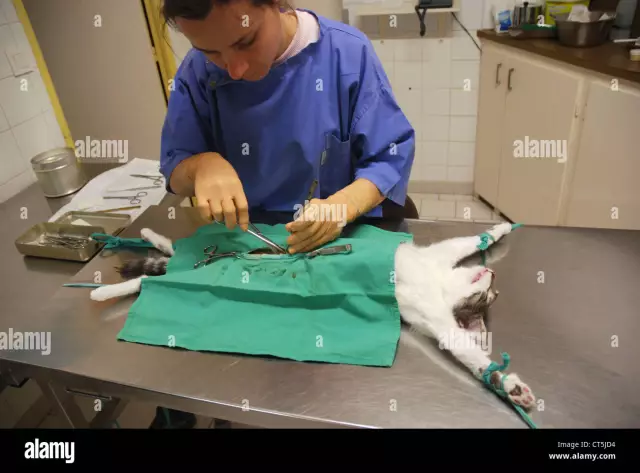- Author Delia Mathews [email protected].
- Public 2023-12-16 00:05.
- Last modified 2025-01-22 15:45.
Castration of a cat is a fairly simple operation. But this is still a surgical intervention, which, moreover, is performed under general anesthesia. Therefore, in order to help the animal to undergo the operation more easily and to avoid possible complications, preliminary preparation is necessary.
Instructions
Step 1
If you decide to castrate a cat, you should not immediately sign up for an operation. First, consult with your veterinarian - let him examine your pet, assess his health. It may be necessary to pass urine and feces tests before the operation - especially if we are talking about an adult animal that could already have time to "earn" urolithiasis (diseased kidneys are a contraindication to surgery). If the cat has infections or parasites, treatment is necessary. The operation can be done no earlier than three weeks after that.
Step 2
If the cat is not vaccinated, then vaccination must also be carried out before castration - 3-4 weeks. After the operation, the animal's body will be weakened, and the risk of "picking up" an infection will increase.
Step 3
Immediately before the operation, the cat will have to starve. Drugs for anesthesia cause the gag reflex in animals, therefore, operations are performed only on an empty stomach. Stop feeding the animal 12 hours before the operation, and watering - 4-6 hours.
Step 4
If the cat is very nervous during visits to the veterinary clinic, then before going to the operation, you can give him a sedative so that he does not experience additional stress. But in this case, be sure to consult with your veterinarian in advance.
Step 5
Before going to surgery, prepare everything you need to make the postoperative period easier for your cat. The first thing that is needed is a warm and draft-proof place where the cat will "move away" from anesthesia. It is better if the "nest" is located on the floor: in the first hours, the coordination of movements of the cat may be impaired.
Step 6
Remove the filler from the tray. Rigid pellets can injure or clog the wound, so it is best to put torn pieces of paper in the tray for the first week after surgery. You can purchase 2-3 rolls of inexpensive toilet paper for this purpose.
Step 7
You can also purchase a plastic postoperative collar from your veterinarian or pet store to prevent your pet from licking the wound, thereby slowing down the healing process. This problem occurs more often with females neutering, but some cats may also show an increased interest in postoperative sutures. It is impossible to predict in advance how the animal will behave, therefore it is better to prepare the collar in advance.






